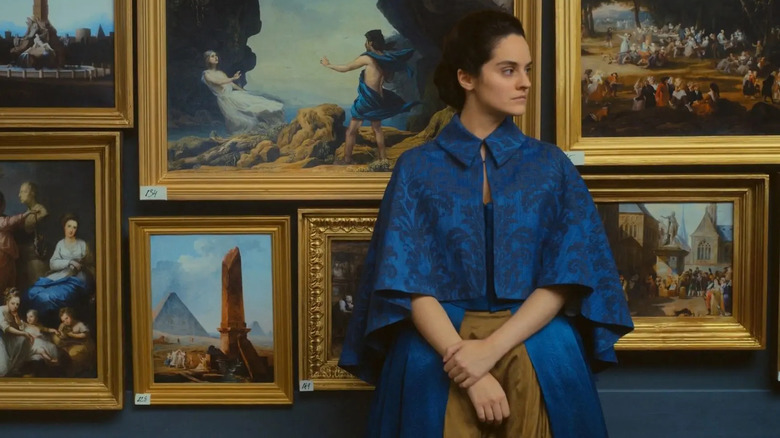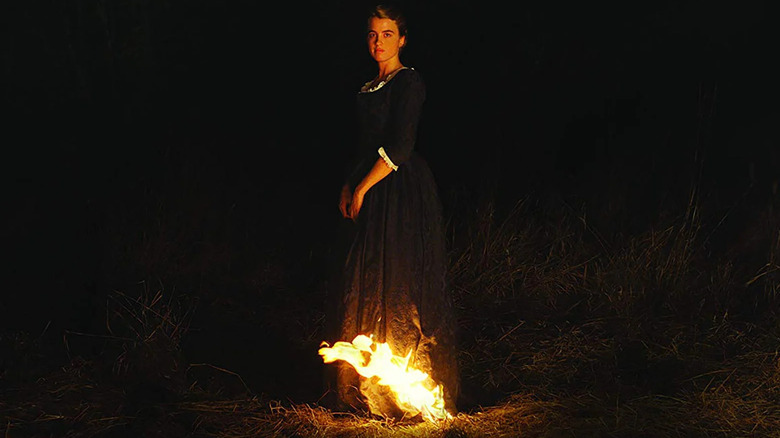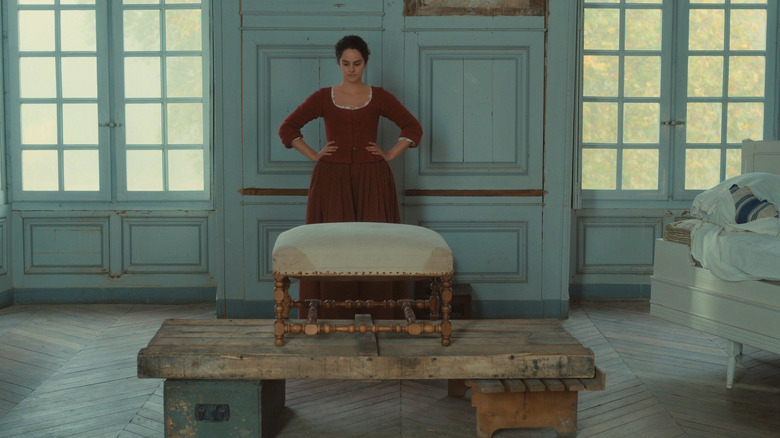Creating The Titular Paintings For Portrait Of A Lady On Fire Was A Massive Undertaking
Céline Sciamma's 2019 romance "Portrait of a Lady on Fire," although only made three years ago, recently appeared in the 2022 Sight and Sound Film Poll as the 30th best film of all time. It won Best Screenplay and the Queer Palm at Cannes, was nominated for 11 César Awards, and topped any number of critics' best-of-the-year lists. And, honestly, it's just that good. When it was released on Blu-ray directly to the prestigious Criterion Collection, few could claim to have batted an eye.
Sciamma's film is about romance, but it's also about looking. Looking at someone, drifting into their eyes, sharing their space, connecting with their heart and body, falling in love with them as a work of art. In the late 18th century, a portrait painter named Marianne (Noémie Merlant) has been commissioned by a dry aristocrat to paint a portrait of Héloïse (Adèle Haenel) as a means of "selling" Héloïse to a potential wealthy suitor. Héloïse wants nothing to do with marriage and only sits for Marianne under protest. The two women are alone on an island together, with only a few scullery workers as company. In constantly staring at one another, the two women fall deeply and passionately in love, seemingly the most natural thing in the world. Their mutual bliss in each other's presence is palpable, gorgeous, and transcendent. Sciamma creates a male-free utopia wherein women's hearts, heads, and hands are all that exist.
To date, "Portrait of a Lady on Fire" might be the most significant modern cinematic example of what might be called the Female Gaze. As opposed to the common Male Gaze, which seeks to objectify, the Female Gaze seeks to absorb and appreciate.
The portraits
Of course, one cannot make a movie about a portrait painter without, well, portraits. One of the conceits of Céline Sciamma's screenplay is that the portrait of Héloïse is never quite right, and Marianne has to start again several times. As it so happens, that's also what professional painter Hélène Delmaire had to do as well. In a 2019 interview with Garage, Delmaire spoke at length about having to paint many, many portraits for "Portrait of a Lady on Fire" until she, Sciamma, and the film's cinematographer, Claire Mathon, felt they were perfect. Also, as actress Noémie Merlant wasn't a professional painter, any closeups of Marianne's hands and arms actually painting were in fact Delmaire's.
The first of Delmaire's struggles in painting for a camera was ensuring that her body was positioned in such a way that she didn't block the lens. She said:
"[Claire Mathon] was right behind me. I couldn't actually move very much and I had to be slightly at an angle, which was quite tricky as I had to be careful not to revert back to my natural position, otherwise I'd hear 'move your head.' It's quite strange but you get used to it pretty quickly."
She also said that, because of the live painting and because of the demands of modern filmmaking, she had to make multiple copies of the same painting. Although there are but two notable portraits in the film, Delamire painted about 14. She said:
"I can paint it by heart now. I had to do one different portrait for each sequence of the film, which ended up being six or seven versions of each of the main two portraits, which is an enormous amount of work."
Sitting with actresses
While Adèle Haenel spent much of her time on screen posing for portraits, it turns out she was not entirely copacetic to actually sitting in real life. As an actress, she preferred to move, speak, and use her instrument. Sitting still in the same position for many hours was not something she was interested in doing. Indeed, Haenel didn't even like to pose for still photographs, although she did so "She only posed for photos, she hated it actually," Hélène Delmaire said of the actress. "She's an actress, she's not static, she has to be moving all the time. So even sitting down for the photos was quite tricky for her, which was amusing actually."
Delmaire said that the portraits used in the film were distributed among Céline Sciamma, the Centre National du Cinéma Archive, Delmaire's own collection, and — she hoped — at least one to Haenel. As for the film's most important portrait, Delmaire was pleased to recall the moment that everything clicked artistically. As any artist might tell you, one cannot know if a work is done ... until it is. It seems that painting so many portraits, often using a photo for reference, allowed Delmaire to approach exactly what she wanted. She said of the painting:
"That's my favorite one. It just worked. Sometimes you struggle a lot on a piece and then sometimes things just seem to work themselves out seamlessly and that was the case for that painting. I think Céline kept that one."
I certainly would.


